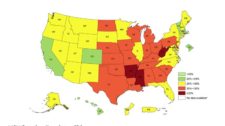 Woman Contemplating Weight Loss courtesy of Shutterstock
Woman Contemplating Weight Loss courtesy of Shutterstock
Anyone who hasn't been living under a rock is surely aware that we have an obesity problem in the United States. As you can see from the map below, self-reported adult obesity prevalence in 2014 was over 30 percent in a large swath of the country (the orange section), and over 35 percent in three states (the dark red).
These prevalence rates have been rising since 1980, according to the CDC. Especially between that year and 2000, the increases were significant for both genders. Data from the National Health and Examination Surveys (NHANES) from 2003-2004 again showed significant increases for men, but not for women, but from the surveys performed in 2011-2012 there were no significant increases for either gender. So that was good news that suggested we might have a handle on the problem. Unfortunately, the good news didn't last.
Dr. Katherine M. Flegal from the CDC and colleagues presented an analysis of obesity data from NHANES 2013-2014, as well as an examination of trends in obesity data from surveys from 2005-2012. Their study was published in JAMA.
Overall, the NHANES crude results from the 2013-2014 survey indicated that 38 percent of American adults were obese (BMI >30) — 35 percent for men, and 41 percent for women. When they examined the prevalence of class 3 obesity (BMI > 40), they found an overall prevalence of 8 percent: 6 percent for men and 10 percent for women. For both genders, the prevalence varied by race/Hispanic origin, with black women having the highest prevalence of both obesity and class 3 obesity compared to non-Hispanic whites, followed by Hispanic women.
An examination of trends across NHANES surveys between 2005 and 2014 revealed little change in obesity and class 3 obesity for men, but a significant increase in both for women during that decade.
As the authors noted, there were limitations to their study:
"The definition of obesity used here is based on weight and height and not on measurements of body fatness. Although BMI and body fatness are highly correlated, the trends observed in BMI may not completely parallel trends in body fatness or in health risks. Body fatness at a given BMI may vary by sex, age group, and race-ethnicity. Health risk at a given BMI may also vary by these factors."
While these limits to the utility of BMI are certainly true, it is unlikely that women categorized as class 3 obesity (BMI >40) would not have excess body fat. Although a high BMI could result from a very muscular physique, it would be unexpected that a sample of women whose BMI was greater than 40 would fall in this category. And of course, the distribution of fat on the body is also important in determining the likelihood of health risk — a central or truncal distribution being more dangerous because it suggests more fat around the internal organs.
What do these data mean for public health? Clearly, we are not succeeding in halting the spread of obesity for all population groups. More targeted attention to those groups most at risk is certainly warranted, with efforts to reach individuals before they reach an obese status.


